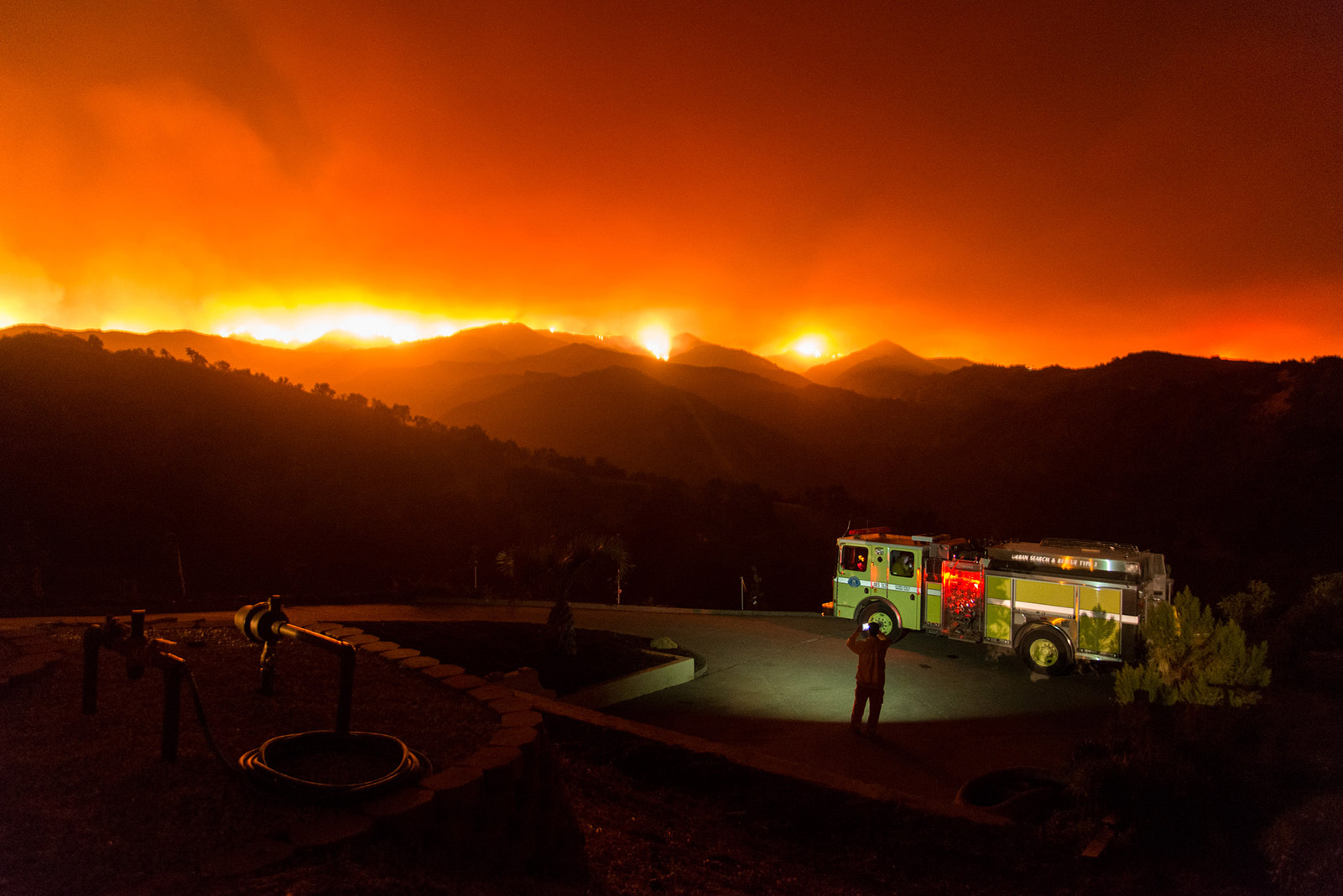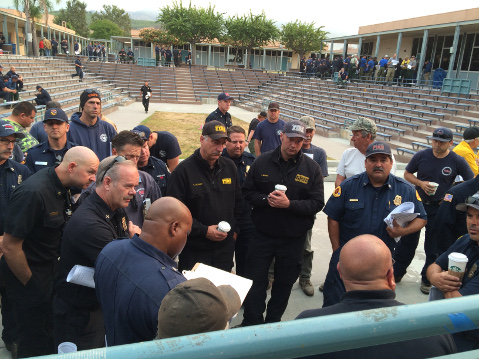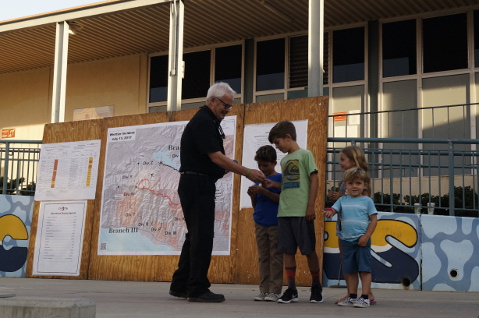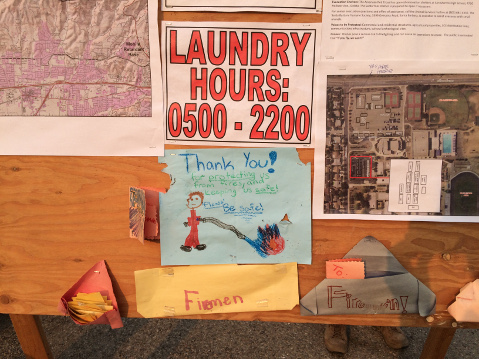Whittier Fire Grows by 3,300 Acres Friday Night
Containment Drops from 52 to 38 Percent

The bad news is that the Whittier Fire, now almost a week old, grew by nearly 3,300 acres Friday night in the face of sundowner winds blowing down the mountains toward the ocean. That total size now is 17,364 acres, up from 13,199 the night before and 7,800 the day it started. The latest containment figures indicate the fire is now 38 percent contained as opposed to 52 percent the night before. The bulk of the growth took place along the fire’s eastern and western flanks; it still remains miles above the neighborhoods ordered evacuated yesterday. While the most of the fire remains sandwiched between Highway 154 and West Camino Cielo, roughly one-fifth of its mass has slopped over West Camino Cielo to the south. According to the Forest Service, the Whittier Fire now has a price tag of $12 million.
The good news is that the winds did not blow as fiercely as anticipated last night and that a marine layer showed up around 1 a.m., which helped retard the fire’s rate of growth. No new structures were reported burned. Spokespeople for Incident Command say the combination of high clouds and the thick carpet of smoke generated by the fire will help keep temperatures lower, at least for the beginning of the day. As long as today’s marine layer holds, that should help tamp things down. But today’s sea fog is expected to hover at 800 feet, at least till it burns off. Yesterday, it started at 1,200. That difference in elevation makes a difference. It governs how the fire will be molested by natural forces at the higher elevations. Mild sundowners are predicted again for later this evening.
“We’re going to get a fire fight today,” declared Incident Commander Mark von Tillow with the U.S. Forest Service. “That thing is coming down the hill.” Von Tillow’s remarks were made at a morning briefing among assembled firefighters at Dos Pueblos High School, where the Incident Command has set up shop. Helping with the fight is the addition of 400 new crew.

One of the clear subtexts at the brief meeting was the critical importance of inter-agency cooperation. With so many different firefighting agencies involved — as with any major wildland fire in California — that’s always important. But it’s become especially key given the high-profile food fight between the head of California’s Office of Emergency Services and the head of the U.S. Forest Service that erupted July 3. Cal-OES is complaining the feds have stiffed local firefighting agencies to the tune of $18 million; the feds are complaining the state has been grossly overcharging. These tensions, long simmering, came to an untimely head just as the map of California exploded in high-profile flames — 12 designated major as of today — and right before the Whittier broke out.
The fire is feasting in some areas on old fuels that have not burned since 1955 and in others where this year’s drought-busting rains have reaped a bumper crop of fire-loving grasses. With much of the terrain steep, crumbly, and inaccessible, fire crews have found it challenging to establish a safe toehold on their lines of containment. As feared, grass-fed flames spotted throughout the night, leaping in some instances as much as three-quarters of a mile from the northerly winds. The plan for Saturday is to bombard areas where the fire is expanding with as much retardant and water as possible. This will only slow the flames down, not put them out. The hope is that the retardant drops will make the fire’s expanding flanks safer for line crews to approach and contain. Deployed into today’s fray are 15 helicopters and six air tankers. Of those, one is classified as a Very Large Air Tanker, or VLAT. In addition, 103 engines have been assigned to the Whittier Fire, as have 18 bulldozers, and 38 fire crews. The total number of personnel assigned to fight Whittier is 1,612.
Firefighters were warned that the fire will lay low in gullies, ravines, and creek channels until they are whipped up by winds. But the weight of all that burning trees and brush — coupled with the laws of gravity — causes flaming masses to tumble downslope. If and when the winds kick into gear, these flames will leap accordingly.
Friday night, two helicopters equipped with night-vision technology were deployed to keep flaring and spotting at bay. Thus far, it appears the fire still remains significantly upslope from the Edwards Reservoir, located in Gato Canyon, between El Capitan and Las Varas canyons. As of this writing, this appears to be the lowest descent of the fire. That’s more than 2,000 feet above sea level.
In the meantime, engine crews have been prepping around suburban subdivisions, laying down hose in preparation for the potential onslaught of flame. Some residents heeded yesterday’s evacuation orders; others remained behind to fight the fire. One resident in El Capitan Canyon expressed optimism that enough fire breaks had been established and enough water resources were available to ride out the storm.
Around Goleta last night, as the fire seemed to wrap around three sections of the horizon, residents grew fearful. “It was scary,” said one walking along Padova Drive. Many have expressed their thanks to the firefighters, and fire spokesperson Mary Sullivan reassured that the crews were very well taken care of for food. “We really appreciate all the gifts,” she said, “but we’re totally taken care of with a full-time staff prepping food.” She said the firefighters’ lunches are often in the 6,000-8,000 calorie range.

One contribution that raised a cheer from the assembled firefighters at a Thursday briefing was from several children who had raised nearly $500 for them at their lemonade stand. Introduced by Santa Barbara City Fire Chief Pat McElroy, the kids received token fire medals in thanks. Apparently, one lemonade purchaser had given them a rare coin that made up the bulk of their earnings, which Chief McElroy said would go to the Santa Barbara Firefighters Alliance. PIO Sullivan added on Saturday that contributions were welcome at the Wildland Firefighter Foundation, which helps families coping with loss. Fire spokespeople have also warned against fake fundraisers, which tend to pop up around disasters.

According to a fire behavior report issued at Saturday’s morning briefing, firefighters are bracing for winds of 10-15 miles an hour by day, and gusts up to 30 miles an hour by night if the sundowners re-materialize as expected. “If North winds develop, expect a significant increase in fire behavior along the front country,” the report read. “Downhill runs of over 250 chains per hour with 45-to-55 flame lengths are possible.” A chain is the equivalent of 66 feet.
The Incident Command has broken the Whittier into three main branches, with branches II and II bordering Calle Real. Branch I is the furthest upslope.
According to the briefing report, Incident Command expects the western flank of the fire to be contained within Camino Cielo during the day, but they expect the fire to make a run down Bear Creek on the northeast. Retardant should slow that down.
As the main fire burns into the charred remnants of last year’s Sherpa Fire, it should slow down some. But if it gets established in the creek drainages, the report warns, “Expect some intense head runs” in branches II and III. If the evening winds develop, “head-wind fire runs could occur with long-range spotting.” These runs could be limited to isolated drainages or manifest across the entire front country. If the latter were to occur — a worst-case planning eventuality — the report predicted, “The fire could impact populated areas in less than 1 hour.”
Related Stories
Firefighters Launch Night Attack on Whittier Fire
The New Normal: California Forest Fires Have Doubled in Size



